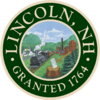Lincoln, New Hampshire facts for kids
Quick facts for kids
Lincoln, New Hampshire
|
||
|---|---|---|
|
Town
|
||
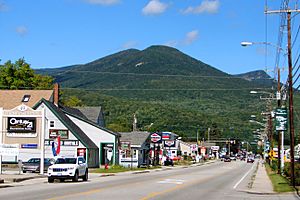
Main Street (NH Route 112)
|
||
|
||
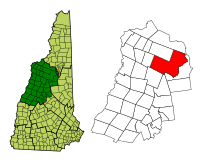
Location in Grafton County, New Hampshire
|
||
| Country | United States | |
| State | New Hampshire | |
| County | Grafton | |
| Incorporated | 1764 | |
| Area | ||
| • Total | 131.0 sq mi (339.3 km2) | |
| • Land | 130.5 sq mi (337.9 km2) | |
| • Water | 0.5 sq mi (1.4 km2) 0.43% | |
| Elevation | 811 ft (247 m) | |
| Population
(2020)
|
||
| • Total | 1,631 | |
| • Density | 12/sq mi (4.8/km2) | |
| Time zone | UTC-5 (Eastern) | |
| • Summer (DST) | UTC-4 (Eastern) | |
| ZIP Code |
03251
|
|
| Area code(s) | 603 | |
| FIPS code | 33-41860 | |
| GNIS feature ID | 0873646 | |
Lincoln is a town located in Grafton County, New Hampshire, in the United States. It is the second-largest town in New Hampshire when measured by its total area. In 2020, about 1,631 people lived there.
Lincoln is known for hosting the New Hampshire Highland Games. A part of Franconia Notch State Park is also within the town's borders. The town is nestled in the White Mountains, and much of it is part of the White Mountain National Forest. The famous Appalachian Trail also runs through parts of Lincoln. It is home to the Loon Mountain Ski Resort, a popular spot for skiing and other fun activities.
The main part of Lincoln, where most people live, is called the Lincoln census-designated place (CDP). It is located along New Hampshire Route 112, just east of Interstate 93. The town also includes areas that used to be small villages, like Stillwater and Zealand. These areas are now part of the White Mountain National Forest.
Contents
History of Lincoln, New Hampshire
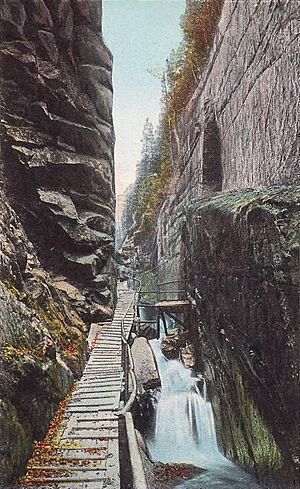
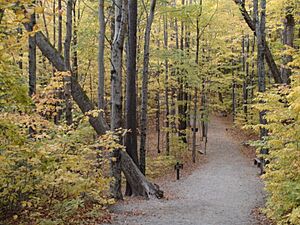
How Lincoln Was Founded
In 1764, Governor Benning Wentworth gave a large area of land, about 32,456 acres (131.3 km²), to a group of about 70 investors from Connecticut. The town was named Lincoln after Henry Fiennes Pelham-Clinton, 2nd Duke of Newcastle. He was also the 9th Earl of Lincoln. He was a cousin of the Wentworth governors and held an important job in London, helping with trade between America and England.
Early Settlement and Industries
People started settling in Lincoln around 1782. By 1790, only 22 people lived there. The land was too rocky for good farming. However, Lincoln had lots of timber and strong water power from the Pemigewasset River. This helped the town grow into a center for logging and sawmills.
By 1853, the Merrimack River Lumber Company was already working in the area. The railroad helped transport wood and also brought more and more tourists to the beautiful mountains.
The Henry Family's Influence
In 1892, James Everell Henry bought about 100,000 acres (405 km²) of untouched forest. He started a big logging business in what is now the center of Lincoln. In 1902, he built a factory to make pulp and paper. He also built the Lincoln House hotel in 1903. A fire in 1907 almost destroyed the whole community, but it was rebuilt. Until he passed away in 1912, Henry was in charge of his "company town". He even put his relatives in important town jobs.
Changes in Ownership and Industry
After Henry died, his family sold the business to the Parker Young Company in 1917. Then, in 1946, it was sold again to the Marcalus Manufacturing Company. Franconia Paper took over in 1950. They made 150 tons of paper every day until they went out of business in 1971. Around that time, new rules about river cleanliness made it hard to continue making paper in Lincoln.
Lincoln's Focus on Tourism
Today, tourism is the main business in Lincoln. Loon Mountain has always been popular with skiers. In recent years, it has tried to become a place people visit all year round, not just for winter sports.
The Flume is one of the most visited attractions in New Hampshire. It was discovered in 1808. It is a natural canyon that stretches about 800 feet (240 m) at the base of Mount Liberty. The walls of granite rock are 70 to 90 feet (21 to 27 m) high and only 12 to 20 feet (3.7 to 6.1 m) apart.
Geography of Lincoln
Lincoln has a total area of about 339.3 square kilometers (131.0 sq mi). Of this, 337.9 square kilometers (130.5 sq mi) is land, and 1.4 square kilometers (0.5 sq mi) is water. This means water makes up about 0.43% of the town's area. Lincoln is the second-largest town in New Hampshire by area, right after Pittsburg.
The Pemigewasset River and its East Branch flow through Lincoln. Most of Lincoln's water flows into the Merrimack River watershed. However, the western edge of town is part of the Connecticut River watershed. Kancamagus Pass, which is 2,860 feet (870 m) high, is on the Kancamagus Highway at the eastern border of the town. The highest point in Lincoln is the top of Mount Bond, which is 4,698 feet (1,432 m) above sea level.
Population of Lincoln
| Historical population | |||
|---|---|---|---|
| Census | Pop. | %± | |
| 1790 | 22 | — | |
| 1800 | 41 | 86.4% | |
| 1810 | 100 | 143.9% | |
| 1820 | 32 | −68.0% | |
| 1830 | 50 | 56.3% | |
| 1840 | 76 | 52.0% | |
| 1850 | 57 | −25.0% | |
| 1860 | 71 | 24.6% | |
| 1870 | 71 | 0.0% | |
| 1880 | 65 | −8.5% | |
| 1890 | 110 | 69.2% | |
| 1900 | 541 | 391.8% | |
| 1910 | 1,278 | 136.2% | |
| 1920 | 1,473 | 15.3% | |
| 1930 | 1,548 | 5.1% | |
| 1940 | 1,560 | 0.8% | |
| 1950 | 1,415 | −9.3% | |
| 1960 | 1,228 | −13.2% | |
| 1970 | 1,341 | 9.2% | |
| 1980 | 1,313 | −2.1% | |
| 1990 | 1,229 | −6.4% | |
| 2000 | 1,271 | 3.4% | |
| 2010 | 1,662 | 30.8% | |
| 2020 | 1,631 | −1.9% | |
| U.S. Decennial Census | |||
According to the census from 2010, there were 1,662 people living in Lincoln. There were 794 households, and 439 of these were families. Many homes, about 73.4%, were empty, mostly used for vacations or seasonal stays.
Most of the people in Lincoln were white (96.9%). A small number were African American (0.3%), Native American (0.1%), or Asian (1.7%). About 1.7% of the population identified as Hispanic or Latino.
In terms of age, 18.7% of the people were under 18. About 20.4% were 65 years old or older. The average age in Lincoln was 48.5 years. For every 100 females, there were about 105 males.
From 2011 to 2015, the average yearly income for a household was estimated to be $37,095. For families, it was $55,326. The average income for each person in the town was $24,109. About 21.0% of the population and 9.1% of families lived below the poverty line.
Fun Places to Visit in Lincoln
- Clark's Bears (used to be Clark's Trading Post)
- Franconia Notch State Park, which includes:
- Hobo Railroad
- Loon Mountain ski resort
- Whale's Tale Water Park
See also
In Spanish: Lincoln (Nuevo Hampshire) para niños


